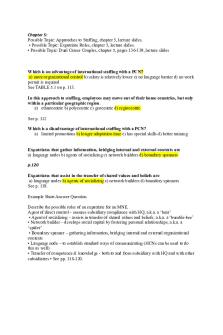MGMT3025-Chapter 5 Example Exam Questions & Answers PDF

| Title | MGMT3025-Chapter 5 Example Exam Questions & Answers |
|---|---|
| Course | International Human Resource Management |
| Institution | Australian National University |
| Pages | 2 |
| File Size | 91.3 KB |
| File Type | |
| Total Downloads | 90 |
| Total Views | 152 |
Summary
MGMT3025-Chapter 5 Example Exam Questions & Answers...
Description
Chapter 5: Possible Topic: Approaches to Staffing, chapter 5, lecture slides. • Possible Topic: Expatriate Roles, chapter 5, lecture slides. • Possible Topic: Dual Career Couples, chapter 5, pages 136-139, lecture slides
Which is an advantage of international staffing with a PCN? a) more organizational control b) salary is relatively lower c) no language barrier d) no work permit is required See TABLE 5.1 on p. 113. In this approach to staffing, employees may move out of their home countries, but only within a particular geographic region. a) ethnocentric b) polycentric c) geocentric d) regiocentric See p. 112 Which is a disadvantage of international staffing with a PCN? a) limited promotions b) longer adaptation time c) has special skills d) better training
Expatriates that gather information, bridging internal and external contexts are a) language nodes b) agents of socializing c) network builders d) boundary spanners p.120 Expatriates that assist in the transfer of shared values and beliefs are a) language nodes b) agents of socializing c) network builders d) boundary spanners See p. 119. Example Short Answer Question Describe the possible roles of an expatriate for an MNE. Agent of direct control – ensures subsidiary compliance with HQ; a.k.a. a ‘bear’ • Agent of socializing – assists in transfer of shared values and beliefs; a.k.a. a ‘bumble-bee’ • Network builder – develops social capital by fostering personal relationships; a.k.a. a ‘spider’ • Boundary spanner – gathering information, bridging internal and external organizational contexts • Language node – to establish standard ways of communicating (HCNs can be used to do this as well) • Transfer of competence & knowledge - both to and from subsidiary with HQ and with other subsidiaries • See pp. 118-120.
Chap 5 Example Essay Qn: Past performance may have little to no bearing on an expatriate’s ability to achieve a task in a foreign setting, but cross-cultural suitability definitely does. Discuss the adjustment variables an MNE employee must satisfy to perform well on an international assignment. Your discussion should include attributes of intercultural competence; antecedents and adjustment modes; and psychological and socio-cultural adjustment. Any diagrams you can draw to illustrate your discussion are a plus. While organizing your thoughts, put yourself the expatriate. “What am I going to need culture-wise?” Figure 5.4 may be a good mental model to help organize as well. 1. Soft skills 2. Intercultural competence – the ability to function effectively in another culture • various attributes: cultural empathy, adaptability, diplomacy, language ability, positive attitude, emotional stability, maturity • affective dimension – my emotional attitude to the foreign culture • cognitive dimension – my culture-specific knowledge • ability dimension – my actual intercultural behaviour 3. Cultural intelligence – ability to grasp, reason, and behave effectively in culturally diverse situations 4. Ability to adjust to a foreign culture and phases of adjustment: 1) honeymoon phase 2) the party is over phase 3) coming to terms, pulling up phase 4) healthy recovery, leveling off phase...
Similar Free PDFs

Example Chapter 5 Questions
- 13 Pages

Example exam questions solutions
- 8 Pages

Prep-BUL-Example Exam Questions
- 6 Pages

EXAM, questions and answers
- 130 Pages

Exam, questions and answers
- 5 Pages

Exam, questions and answers
- 142 Pages

Exam, questions and answers
- 231 Pages

Exam, questions and answers
- 2 Pages

Exam, questions and answers
- 67 Pages
Popular Institutions
- Tinajero National High School - Annex
- Politeknik Caltex Riau
- Yokohama City University
- SGT University
- University of Al-Qadisiyah
- Divine Word College of Vigan
- Techniek College Rotterdam
- Universidade de Santiago
- Universiti Teknologi MARA Cawangan Johor Kampus Pasir Gudang
- Poltekkes Kemenkes Yogyakarta
- Baguio City National High School
- Colegio san marcos
- preparatoria uno
- Centro de Bachillerato Tecnológico Industrial y de Servicios No. 107
- Dalian Maritime University
- Quang Trung Secondary School
- Colegio Tecnológico en Informática
- Corporación Regional de Educación Superior
- Grupo CEDVA
- Dar Al Uloom University
- Centro de Estudios Preuniversitarios de la Universidad Nacional de Ingeniería
- 上智大学
- Aakash International School, Nuna Majara
- San Felipe Neri Catholic School
- Kang Chiao International School - New Taipei City
- Misamis Occidental National High School
- Institución Educativa Escuela Normal Juan Ladrilleros
- Kolehiyo ng Pantukan
- Batanes State College
- Instituto Continental
- Sekolah Menengah Kejuruan Kesehatan Kaltara (Tarakan)
- Colegio de La Inmaculada Concepcion - Cebu






